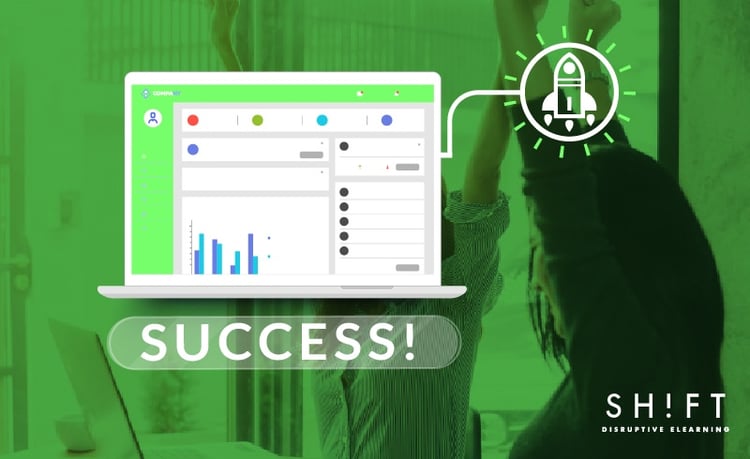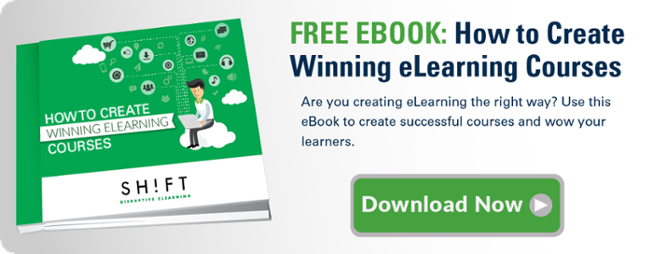Your team has invested some long hours into creating an eLearning course to help your employees address a specific process or learn a new subject. Perfect! The work has been done, the time and money have been invested. You’ve launched your course...and crickets.
Nothing happens. No one is taking your course. As the weeks pass, your team realizes that a lot of time and money has gone to waste.
You can avoid this kind of drama with the right preparation and execution. Preparing for a launch can dramatically increase the success of the launch and overall engagement with your course.

The course launch is actually part of the entire creation process. Its the trickiest part because of all the elements you have to tie together. It requires promoting the benefits and hyping your employees up about the advantages that it will offer. Without a good launch plan, the chance of engagement is pretty low.
There are risks to not handling a launch properly, but the greatest of them all are:
- Setting the participation of your course back
- Losing the value of the time and efforts invested
- Not addressing the problems you created the courses for
Read on to learn five ways to maximize the possibility of a successful launch, optimize the value of your eLearning course, and provide your employees with the information they will benefit from.
1) First Impressions Matter!
Remember how important first impressions are in an interview process? The same importance applies here. The first thing that you need to put together is a short description of your eLearning course that includes the learning objective. Much like an interview, you want to have a clean solid exchange addressing what you have to offer and why it’s beneficial.
A brief overview of its purpose is going to help people understand the what and the why behind your training course. If your learners are aware of the “gist” and key benefits they are going to be less resistant to the time you are asking them to set aside.
So, pen to paper as teachers say. Answer the following questions in a casual, conversational way:
- What’s the problem that you are trying to address?
- How can training help you solve this problem?
- Who is this for?
- What will shift because of the course? What will a learner have (knowledge, skill or direction) after the fact?
Review these answers and start piecing them together. Cut out any words that aren’t needed. Get straight to the reason and benefit to create your quick pitch.
Also, watch out for these mistakes: 5 eLearning Design Mistakes That Can Ruin a Good First Impression
2) Right Timing
Timing is everything! This is truest in literature, love, and eLearning. This is why you have to consider “the right moment” as an influential factor. Aside from the benefits, you can provide your learners with, make a list of suggested moments when the course can come in handy. Make sure to inform them of course length and suggested times when these 20 minutes can be taken advantage of.
Think about what’s going on over the course of the day. You’ll want to get the most exposure and attention possible during launch, so refrain from doing this during hectic delivery dates or major holidays. Better times to do this are during an onboarding, renewing credentials, and after a yearly meeting.
Side note, in case of interruption, make sure that your course bookmarks progress to avoid frustrations. Make it easy for them to jump on and off as the day unravels.
Read more: Start Thinking of Micro Learning Moments Now
3) Building a Buzz
Learners are going to be talking about course if its done right and its helpful to their everyday duties. This momentum is key to a successful launch; that awareness is going to push your program forward.
The elevator pitch that we mentioned in the first point will come into play here. Clarity will help push the buzz. The more people hear about it, the more that description will be used. Make sure to provide all these points at the start of the program: description, average lesson length, etc.
Building a buzz can actually start before the launch. This can be done by hosting a webinar as early as a week before the course launch. This does require planning and time, but it is a great way to inform your employees about what they will be learning and how they can apply it in their everyday duties. Make sure to provide an emphasis on the real value, not just on your bottom line. Make it about them, give them applicable tips, and inform them of everyday concerns or common questions. These small tidbits of information will give you credibility and will establish trust between you and your employees even before they take the course. This will keep them receptive and excited to take it!
Take the great brands of our times as examples. Apple creates a buzz well before launching a product! Artists like Justin Bieber and Beyonce post 15-second clips of unreleased songs and announce official release dates. Fashion and tech bloggers discuss secret projects and the intentions way before they introduce the product to their audience. Building online buzz takes work, but it’s well worth it and works for you in the long run.
Read more: Here's How To Promote Your New eLearning Program Internally
4) Run a Pilot
Before your launch, it’s a good idea to have a group of people engage with what the course you have designed. There is always something else to consider, and then you will find that it’s fine as it is. Listening to different people about their experience can quickly unleash a world of minor changes that result in major improvements. You won’t be able to please everyone, but you will be able to upgrade the quality of the experience.
One way to compete against boredom, skepticism, and learning decay is to stay engaging and innovative. You can only stay ahead of the game by staying open to feedback. This is best done by putting your program to the test!
Some points to consider:
Take the course yourself. When a writer reviews their work as a reader, the text looks different and the editing begins. Sit in the learner’s chair and give it a go.
Invite a select group of people to take the course. Possibly even someone with little to no interest in eLearning and maybe even technically challenged. These disadvantages will give you extraordinary perspective. It is going to extremely useful to the bettering of the eLearning experience.
Begin with a simple questionnaire to evaluate and gather insights:
- Were the instructions clear?
- Were the exercises useful?
- Do they have questions on how to apply skills learned?
- Which parts were not useful?
Planning and implementation can harbor a lot of mistakes, glitches, and nuances. Running a pilot is the only way to discover poor design and experience your course as it really is. Running a pilot will also you make you aware of how important adjustability will be. The success of your course will be entirely dependent on ongoing content updates, platforms improvements, and tweaks.
Also check out this post-launch tips:
Now What? Five Things You Should Do After Launching Your eLearning Course
In conclusion, you’ve worked so hard to arrive at this moment. Every piece of this journey has come together. A proper launch is important as it addresses skepticism, informs on benefits, and hushes disposition. When things are done well, we are often inclined to get involved. Think about everything that will come of a proper launch vs. everything that’s at risk. Learners are going to advance in their roles because of your course, your business will benefit, and your ROI is going to increase. The prep work is worth it!


